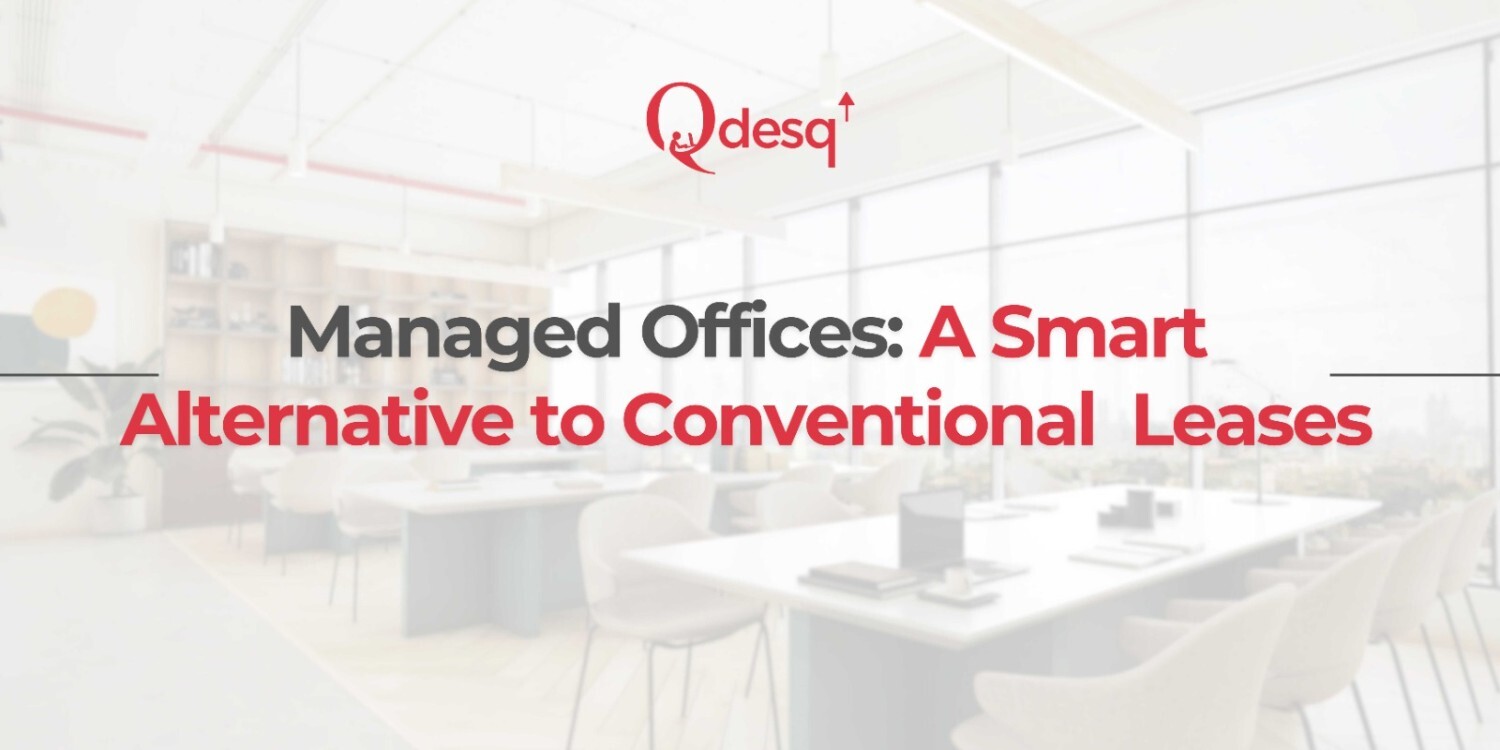India’s corporate real estate landscape is undergoing a profound transformation. Once dominated by conventional long-term leases burdened by high upfront costs, extended commitments, and cumbersome facility management, companies are now pivoting toward agile, serviced solutions. A significant driver of this change? Managed offices, which are part turnkey workspace and part strategic asset, are rapidly gaining ground, driven by hybrid work trends and cost-conscious financial strategies across India’s major metropolitan areas and beyond.
The Momentum Behind Managed Offices
Flexible workspaces are no longer a niche offering—they’ve become a core part of India’s commercial real estate strategy. As of mid-2024, flex space supply in the top 8 Indian cities has crossed 58 million sq ft, accounting for 7–8% of Grade-A office stock. In just 3.5 years, over 450,000 flex seats have been absorbed, highlighting the growing enterprise appetite for agile work models. Qdesq forecasts a 25% rise in flex-office inventory by the end of 2024, with Tier 2 and Tier 3 cities accelerating adoption. In this landscape, Managed Office Solutions (MOS) are emerging as the preferred choice, offering premium infrastructure, faster go-to-market, and scalability without long-term lock-ins.
What Is a Managed Office?
At its core, a managed office is a private, furnished, fully serviced workspace operated by a specialised provider. Unlike coworking spaces with shared desks, these are dedicated to one tenant. Unlike traditional leases, they’re turnkey, and the provider handles everything: interiors, maintenance, utilities, IT infrastructure, and more.
Providers are responsible for design, construction, procurement, and ongoing facility management. Towers of paperwork, electricians, carpenters, vendors? You can skip them. The result: teams can walk in and start working within days, not months. These spaces are equipped with ergonomic furniture, reception areas, video-conferencing booths, cafés, wellness zones, and IT support, all wrapped into a fixed monthly fee.
Cost Efficiency: From CapEx to OpEx
For CFOs, the case for managed offices is rooted in clear cost savings. Traditional leases demand 6–12 months’ rent upfront and ₹1,500–₹2,500 per sq ft in fit-out costs—often crossing ₹2 crore for a modest 10,000 sq ft setup. Add monthly overheads, such as staffing, utilities, pantry, and maintenance, and expenses quickly rise by ₹5–10 lakh per month.
Managed offices flip this model. Deposits are lower—typically just 1–3 months’ rent—and there’s no capital expenditure. Everything is bundled into one monthly payment: rent, security, housekeeping, IT, and more. Budgeting becomes predictable, and cash flow remains smooth.
Reports from CBRE and JLL suggest that switching to managed spaces can reduce total occupancy costs by 25–30%, while also converting heavy upfront investments into manageable operational expenses. Providers also optimise layouts to minimise unused space and often secure premium locations at lower all-in costs, making it easier for companies to afford a professional HQ without long-term financial strain.
Operational Simplification
Managed offices offer single-point accountability. Providers handle housekeeping, pest control, maintenance, and minor repairs. Reception, IT help desk services, security, and a pantry are all included. Administrators gain peace of mind; they no longer have to juggle electricians, cleaners, or internet service providers.
This operational simplicity saves administrative burden and streamlines vendor interaction. One consolidated bill per month helps finance teams avoid surprises, such as a sudden A/C repair, since issues are proactively addressed. Fixing a broken printer? The provider handles it. Missing chair? They’ve got extras.
Speed & Agility
Time is often the most valuable asset in business. Traditional leases typically come with build-out timelines of three to six months, and sometimes longer, depending on whether municipal permits are required. With a managed office, that timeline shrinks to mere days. Qdesq confirms that teams can “move in and start operations within days instead of months”.
For dynamic or growth-oriented companies, those expanding sales teams, opening satellite offices, or launching quick pilots, this speed is transformative. It eliminates project management delays, minimises business risk, and grants a first-mover advantage.
Strategic Flexibility & Scaling
Managed offices come with modular lease terms, ranging from monthly to annual, with negligible exit penalties. A growing startup can swiftly triple space, while a firm facing uncertainty can downsize without penalty. Compare that with the rigidity of traditional leases, where scaling a 3-year commitment mid-lease can become expensive and cumbersome.
Experts advise (via Qdesq) that the most effective workspace strategies often involve layered portfolios, which include a long-term HQ lease supplemented by flexible spaces in secondary locations. This model combines brand visibility, operational bases, and delivery hubs, making it ideal for hybrid, regional, or project-centric teams.
Tier‑2/3 expansions also benefit. With costs lower and demand rising (Q2–Q3 2023 saw a 5–8% spike in desk rates outside metros), flexible managed offices are ideal for controlled geographic plays.
Enhancing Employee Experience
A well-designed workspace matters. Incuspaze highlights the lag in older corporate setups, which often lack natural light, ergonomic design, and communal zones, while managed spaces prioritise on-trend layouts and comfort. High-quality furniture, wellness rooms, Zoom booths, cafés, and lounges are now standard.
Research suggests that thoughtfully crafted work environments can boost productivity by ~16%, according to a Harvard Business Review article cited by TRIOS. Smartly equipped managed spaces not only please employees, but they also attract talent and aid retention.
In addition, these spaces often sit within larger campuses or flex hubs that foster community, including networking events, peer interactions, and informal collaboration, while preserving tenant-specific privacy and branding.
Tech-Enabled, Sustainable, Community-Centric Growth
As we enter 2025, managed office providers are layering technology, such as smart controls, app-based room booking, and access systems, into their offerings, meeting mature expectations for efficiency and convenience. Sustainability is also rising on operator agendas, with green certifications and eco-conscious designs now part of Grade-A flex developments.
Furthermore, as noted by Qdesq, the future will be characterised by ecosystem-based managed spaces that combine workspace, wellness, events, mentorship, and cross-company programming.
Summary
| Feature | Traditional Lease | Managed Office |
| CapEx | High fit-out + heavy deposits | Minimal (1–3 months deposit) |
| OpEx | Utilities, staff, and repair bills | Bundled fixed monthly fee |
| Setup Time | ~3–6 months + approvals | Ready in days |
| Term Flexibility | Lock-ins, scale penalties | Month-to-month to 1-year, scalable |
| Mgmt Overhead | Multi-vendor coordination | Single operator support |
| Employee Experience | Basic setups: dusty corridors | Ergonomic, branded, amenity-rich |
| Strategic Agility | Risk in scaling/shrinking | Easy alignment with business goals |
Looking Ahead
Managed offices are no longer a trend; they’re a strategic pillar in India’s fast-changing workspace landscape. With 25% flex market growth expected in 2024 and hybrid work on the rise, managed spaces offer CFOs and CRE heads an innovative, scalable solution. From startups to global MNCs, businesses are now turning to managed offices for faster expansion, cost efficiency, and a better employee experience.
Final Thought
In a competitive, hybrid-era workspace world, the question is no longer if to go managed but how to blend these bright, serviced spaces into your real estate canvas. With baked-in convenience, cost control, and customisation, managed offices aren’t just practical—they’re strategic.











